8 SWOT analysis
Luka Mihailovic, Brayden Seneca, Tanisha Shekdar & Madison Veperts
S.W.O.T. Analysis
February 27 2018
SWOT analyses are performed by organizations allowing for identification of a company’s strengths and weaknesses, as well as external opportunities and threats. This tool is meant to identify the goals of an intended business and to highlight possible advantages and disadvantages to the business by analyzing internal and external factors. This is why SWOT analysis is sometimes referred to as Internal-External Matrix. This kind of strategic formulation is often key to the development of a business.
SWOT analysis is a relatively simple way to discover major advantages and obstacles that a company or project has to face. This information is very valuable to determine if the project is worth moving forward or not. With too many obstacles and disadvantages, it may be more beneficial to terminate. This is why SWOT is often completed in the idea stage of a business plan or project.
How to conduct a SWOT analysis
The best way to conduct a SWOT analysis is with a group brainstorming different ideas and perspectives in relation to the company. Group members from different parts of a company can all contribute to the development of a SWOT analysis.
Factors in the plan should be prioritized by relative significance to the overall development of a business/project. This can be done by meticulous analysis of every possible factor that could have an impact, whether positive or negative on business development.
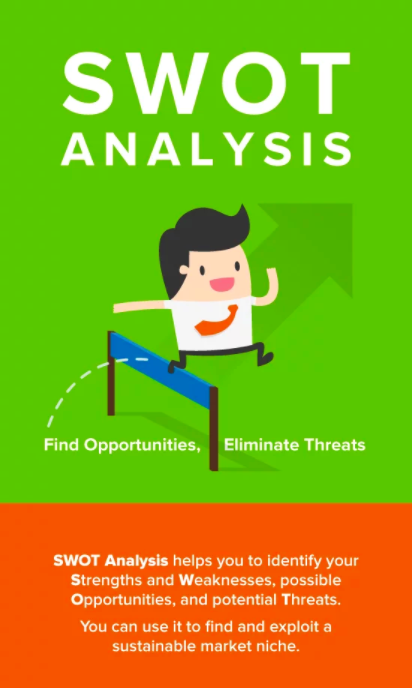
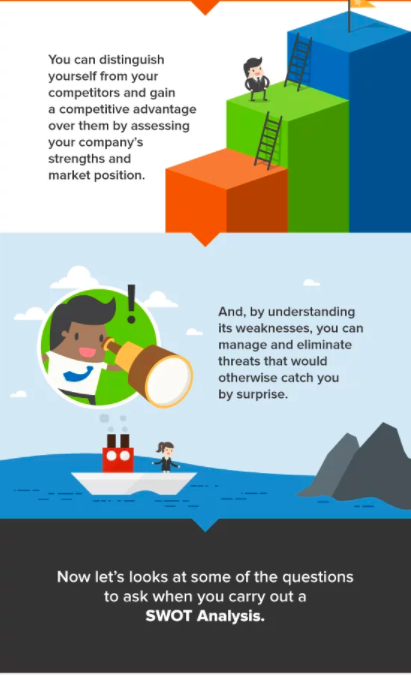
Strengths
The ability to identify strengths of a company, business or idea, is key in building a foundation for success. This tool is an internal positive, the strengths of the company do not rely on external factors. The identification of advantages over the competition and what the particular business/company is able to do better than others is of utter importance. The strengths identified will increase the internal confidence within, that the business will be successful.
When identifying ones strengths, there is no need for modesty. These factors are those that will make the company successful. Many of the strengths that can be identified, can lead to further opportunities, as well as future gains. The strengths listed by any business or company can be in terms of their production line, group of employees, any particular sets of skills and the ability to be competitive & profitable within the defined market.
All strengths will be identifiable on the basis that they will play a role in success. The success of companies is typically related to the profit margin. Profits can be based on either direct factors or indirect factors. Identification of all strengths, is important in internal confidence and awareness as to what is brought to the table in every aspect by the company, business or even individual.

Weaknesses
Identifying key weaknesses is vital to establishing a business strategy. These are often direct internal factors that are detrimental to the overall plan, but can also be underlying external elements. The negative impact these factors have is usually seen as a general decrease in overall sales. However these weaknesses do not have to be existing problems with the company. They can also be hypotheticals or factors that can be avoided, as well as situations the company or project can improve upon.
An important aspect in this section is perspective. You need to see how your company and factors affecting it are perceived by other companies as well as the general market. Very often something that doesn’t seem like a weakness to a company is overlooked when to other competitors or consumers it is. This is why before even analyzing a company’s own weaknesses it must first take a step back and perceive itself from the viewpoint of the market.
Another key detail in weakness analysis is that it must be rigorous and realistic. You must be thorough in highlighting every potential problem even if some seem unlikely or minor. No matter how small a weakness seems, it is important to identify it and determine its severity.
Some examples of weaknesses within a company could be:
- Limited access to resources
- Little recognition within the market
- Unknown brand name
- Insufficient staff or staff with a narrow skillset
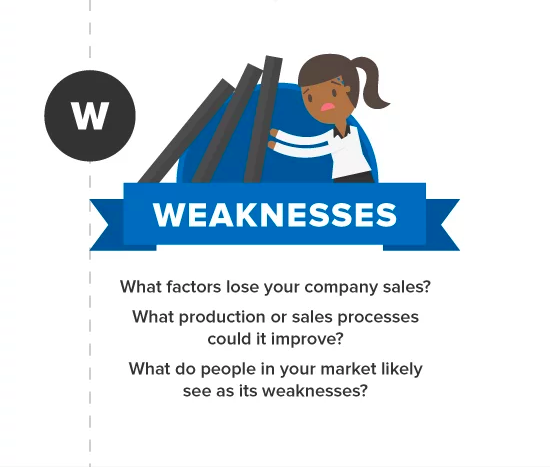
Opportunities
Opportunities usually refers to external attractive factors that represent reasons why you or your business may flourish. These are factors that a business or an individual can capitalize or use to their advantage. When looking at opportunities for a business, its is best to look at strengths and ask whether these open up any opportunities. This can also be applied to weaknesses; you can look at a company’s weaknesses and ask whether opportunities could be opened up by eliminating these weaknesses.
When looking at opportunities, a business or individual must consider what kinds of opportunities exist in their market or environment that they can benefit from? For example, if an individual is trying to promote their personal training business, they may exploit social media platforms such as instagram and facebook pages to promote themselves especially because a majority of their client base uses these platforms. Local events also pose a potential for opportunities; this allows for possible partnership opportunities as well

Threats
Determining the threats is one of the most important aspects of the SWOT analysis. The weaknesses that were previously determined are used to see if they are viable threats. Along with looking at the internal weaknesses of the company or project, it is also important to determine the external threats of competitors.
Other threats can come from the obstacles the company faces. For example, are there laws in place that you need to be aware of? Are there patents that you need to avoid? These are just some of the many obstacles a project could face that the company has to be aware of.
Some threats may involve technology. This can include if technology is changing and improving. It is often very important to stay technologically relevant because most technology changes can threaten a business or project. Once all threats have been determined it is necessary to take action to prevent said threats. If there are too many threats and not enough solutions, termination of the project may be necessary.
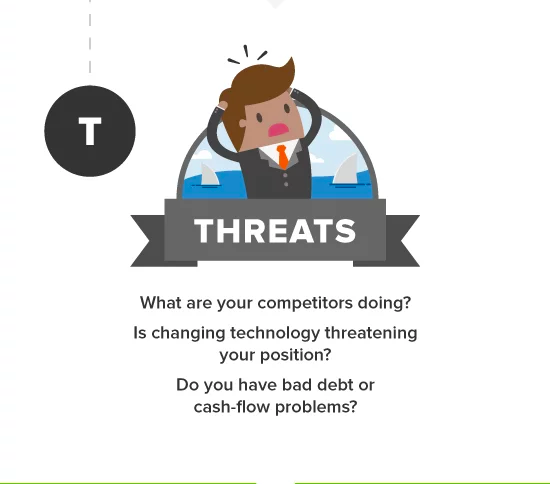

SWOT Analysis Video Explanation
Example Using PepsiCo
PepsiCo is a very well established company that was formed as a result of a merger between two food industry giants, the Pepsi-Cola Company and Frito-Lay, Inc. However, the organization has also since then acquired various other food companies such as Tropicana Products, and the Gatorade brand. It is the world’s leading producer of convenient snacks, foods and beverages with over 63 billion in annual sales and 263, 000 employees in 200 countries. Since the company started their SWOT analysis has definitely changed drastically, however here is an analysis of PepsiCo today.
Strengths
No company can become as widely renowned and successful as PepsiCo without multiple strengths in the business. The two most prominent strengths PepsiCo has going for them right now would be current sponsorship deals and their diversified product line.
Sponsorship deals have been made with professional sports leagues in North America, including the NHL, NBA, MLB and NFL. The NHL and NHLPA has recently (Jan 2018) inked a five year deal with PepsiCo, which is the largest partnership agreement in league history. This is a resigning to a previous agreement, which saw PepsiCo have full rights to the non-alcoholic beverage, sports nutrition and snacks categories. These partnerships lead to strong marketing abilities as professional sports venues and events can be utilized to unveil new products.
A diversified product line brings an advantage to PepsiCo over its main competitors as they are not just a one trick pony. The long and arduous battle with Coca-Cola over soft drink supremacy had been ongoing for decades. However, the overall success of PepsiCo does not rely solely on outcomes in the Cola Wars. Non-carbonated beverages are crucial to the success of PepsiCo, these products include Gatorade and Lipton Teas. Straying away from beverages, Lay’s chips have a strangle-hold atop their respective savory snacks market and show no signs of slowing.
A third strength of PepsiCo is that they have a clearly defined target audience; youth. Unlike competitors, all advertisements for company products are created and directed towards younger crowds. Finally, the world-wide distribution of products from this company is astronomical in nature. Over 200 countries benefit from the product line that is PepsiCo, allowing for a strong distribution network.
Weaknesses
Surprisingly, even as a world-renowned food company Pepsi still has several areas that could use improvement as well as weaknesses to the overall brand. Some of these are even as a direct results of the companies recognition. As a major company PepsiCo is constantly under the spotlight and under criticism. An example from the past several years was that the company experienced media backlash for claiming their products were make using pure spring water, when in reality they used tap water as well as overusing water in areas where water is not readily available.
Also, similar to other snack food and beverage companies, PepsiCo is under continuous scrutiny due to health concerns over their products. The soda lines in the company are among its weakest revenue generators. This is due to the fact that less people are buying soda and looking for healthier alternatives. This will force PepsiCo to develop or explore non-carbonated lines of drinks.
Another weakness that Pepsi has is its over reliance on one major customer in the form of Wal-Mart. This customer represents approximately 13% of the total annual revenue of PepsiCo. Any decline in sales to Wal-Mart could result in a drastic reduction in total sales. This can be even more potent considering that Wal-Mart is a massive company in itself that PepsiCo has little power over. PepsiCo also has an overdependence on developed markets which account for 69% of sales. The company in the future should focus on the markets in underdeveloped countries like several of its other competitors.
PepsiCo also has a smaller net profit margin in comparison to competitors. This is the total profit relative to total revenue generated. PepsiCos profit margin of 8.6% is almost half of The Coca Cola Companies 16.6%. The company should devote resources into lowering the costs of manufacturing and selling their various products.
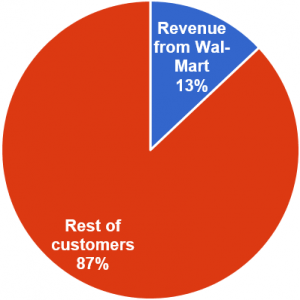
Opportunities
People are starting to become more health conscious; therefore, there in an increased demand for healthy snacks, food and beverages worldwide. Additionally, obesity is a growing concern for many developed nations and there have been many attempts to try and fight this growing pandemic with the use of laws to decrease consumption of fats, salts, and sugars. PepsiCo is aware of this growing concern and has therefore introduced ‘Good for You’ brands which includes nutritious products such as fruits, seeds, whole grains, and low-fat dairy with limits on sodium, sugar, and saturated fats.
In 2015, ready to drink teas and coffees is a booming industry and are some of the fastest growing beverage segments in the U.S market. As a result, PepsiCo has partnered up with Starbucks and Lipton in RTD coffee and tea segments. However, the company has no brands of its own; if they were to create its own RTD brand, it could possibly generate more revenues and higher profits.
Bottled water is one of the largest beverage segments and is one of PepsiCo’s key products. The beverage marketing corporation reveals that bottled water consumption grew from 7.3% in 2014 to 7.9% in 2015. PepsiCo sells Aquafina and LifeWTR brands successfully to its consumers. The company should strengthen its portfolio by adding more brands.
Threats
Although PepsiCo has many products, the one they are most known for is Pepsi. One of the main threats of Pepsi is Coca-cola. Coca-cola uses large scale marketing and is the clear soda giant. This limits the pricing of Pepsi since they have to compete with Coca-cola.
On a larger scale, a major threat for PepsiCo is the amount of water needed to produce all of their beverages. Water is a limiting resource in many countries and many places have water shortages. In the future it may be difficult to access clean inexpensive water.
The U.S dollar exchange rate will continue to increase against other currencies. This will become a threat to PepsiCo since a large portion of their revenue is generated outside of the states (about 44%). Due to the rise in the USD, the profits made outside of the U.S. will lose value when converted back into USD.
Another threat to PepsiCo is that a lot of their products contain large amounts of sugar. Excess amounts of sugar consumed in diet is a leading cause of diabetes and also may contribute to cancer. The U.S. government may be passing legislation that product labels must disclose such information. This puts PepsiCo at risk for losing customers and a threat to their business.
Conclusion
The SWOT analysis is best performed at the beginning of a new project or business venture to create a marketing action plan. By looking at the strengths, weaknesses, opportunities, and threats, it outlines a course of action to follow. However, this analysis can be performed later on and can be useful to help change, point the project or company in the right direction, and take the greatest possible advantage of opportunities available. The use of SWOT is important to gain an understanding of a company or individual’s competitors as well as their future endeavours.
Appendix
Justin Hellman. 2016. PepsiCo, Inc.: A quick SWOT analysis. [ONLINE] Available at: http://www.valueline.com/Stocks/Highlights/PepsiCo,_Inc___A_Quick_SWOT_Analysis.aspx#.WpOHIoPwbIV [Accessed 23 February 2018].
Ovidijus Jurevicius. 2016. PepsiCo SWOT analysis. [ONLINE] Available at https://www.strategicmanagementinsight.com/swot-analyses/pepsico-swot-analysis.html. [Accessed 23 February 2018].
Mind Tools Content Team. 2018. SWOT Analysis. [ONLINE] Available at: https://www.mindtools.com/pages/article/newTMC_05.htm. [Accessed 23 February 2018].
Susan Ward. 2017. SWOT Analysis Example (Strengths, Weaknesses, Opportunities, Threats). [ONLINE] Available at: https://www.thebalance.com/swot-example-strengths-weaknesses-opportunities-threats-2947985. [Accessed 23 February 2018].
Margaret Rouse. 2017. SWOT analysis (strengths, weaknesses, opportunities and threats analysis). [ONLINE] Available at: http://searchcio.techtarget.com/definition/SWOT-analysis-strengths-weaknesses-opportunities-and-threats-analysis. [Accessed 23 February 2018].
PepsiCo Canada. 2018. PepsiCo, NHL and NHLPA Ink Multi-year North American Strategic Alliance. [ONLINE] Available at: https://www.newswire.ca/news-releases/pepsico-nhl-and-nhlpa-ink-multi-year-north-american-strategic-alliance-671073053.html. [Accessed 23 February 2018].
Hitesh Bhasin. 2018. SWOT Analysis of Pepsi – PepsiCo SWOT analysis. [ONLINE] Available at: https://www.marketing91.com/swot-analysis-pepsico/. [Accessed 23 February 2018].
Business Queensland. 2017. Example SWOT analysisI. [ONLINE] Available at: https://www.business.qld.gov.au/starting-business/planning/market-customer-research/swot-analysis/example. [Accessed 23 February 2018].
